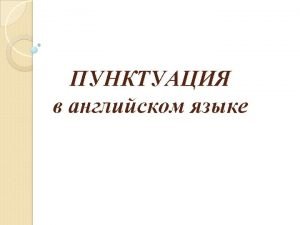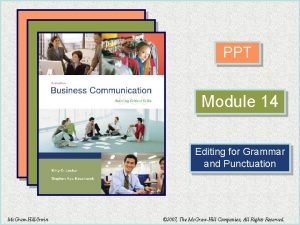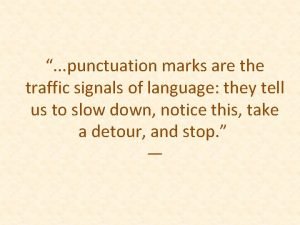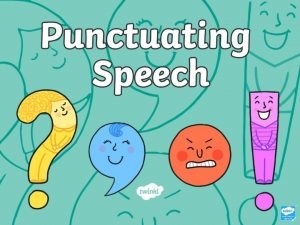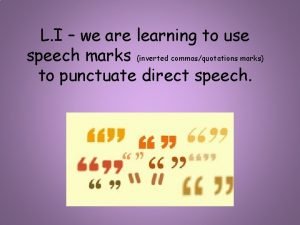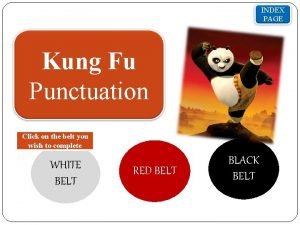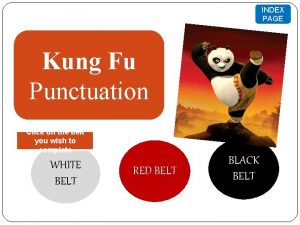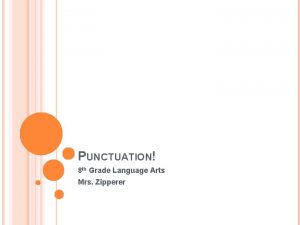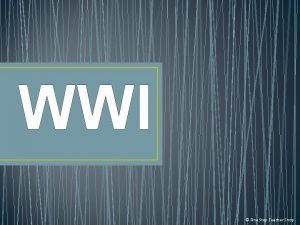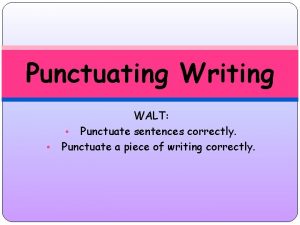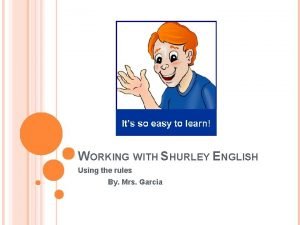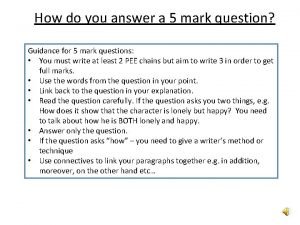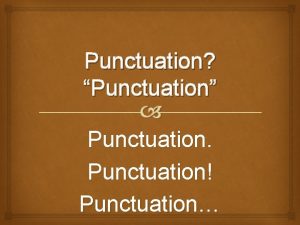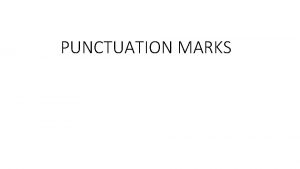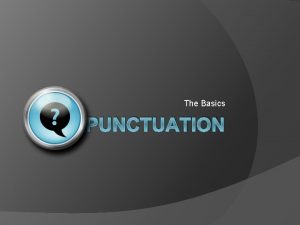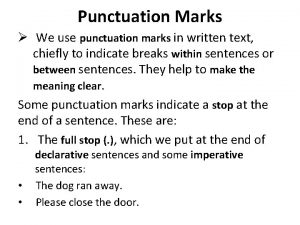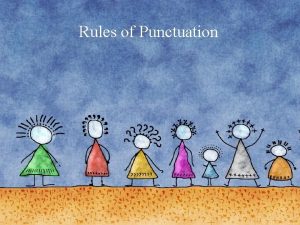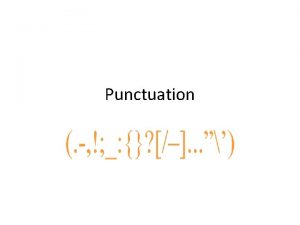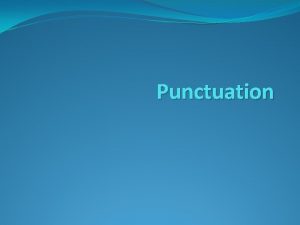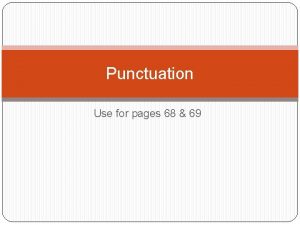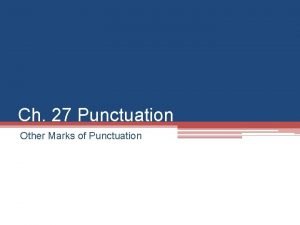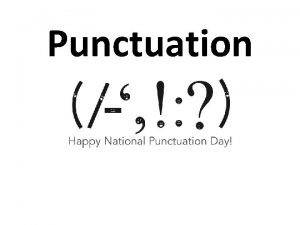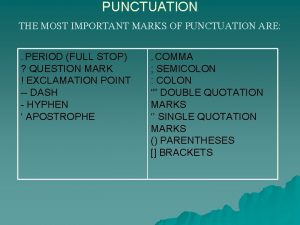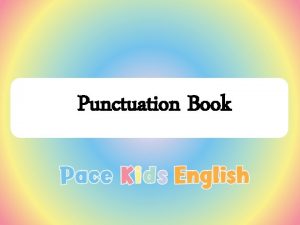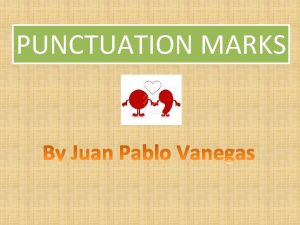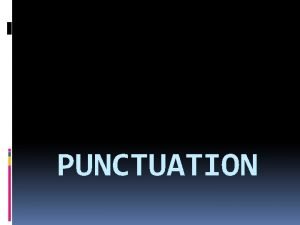The punctuation marks in English are full stop













![( ) [ ] { } � brackets or parentheses square or box brackets ( ) [ ] { } � brackets or parentheses square or box brackets](https://slidetodoc.com/presentation_image_h2/7411ed39efdfb75206e5520ebbfe22d6/image-14.jpg)






- Slides: 20


The punctuation marks in English are:

full stop / dot � � We put a full stop at the end of each sentence, unless it is a question or needs an exclamation mark (e. g. ‘My uncle lives in Newfoundland. ’). It is also used with abbreviations (e. g. ‘e. g. ’ and ‘Mrs. ’). The full stop is called a dot when it appears in a website address (URL) or an email address, e. g. https: //purlandtraining. com (‘ dot com’).

comma � We use commas to separate clauses in a sentence – often before conjunctions, e. g. ‘I need to hurry up, because the bus is leaving soon’. If there wasn’t a conjunction (‘because’) we would need to use a semi-colon rather than a comma, because a comma wouldn’t provide a long enough pause to make the information clear:

apostrophe � We use an apostrophe before an ‘s’ to show that something belongs to somebody or something (e. g. ‘Paul’s pencil’). If the noun is plural and ends in ‘s’ we put the apostrophe after the final ‘s’ to make the possessive phrase, e. g. ‘The books’ owner’ not ‘The book’s owner. ’ We also use an apostrophe to show that part of a word is missing, e. g. with contracted verb forms, like ‘It’s raining’ (the apostrophe replaces the ‘i’ of ‘is’) and ‘Sarah’s gone home early’ (the apostrophe replaces the ‘ha’ of ‘has’).

? � question mark A question mark is used at the end of a question, instead of a full stop (e. g. ‘What time does the film start? ’).

! � exclamation mark We put the exclamation mark at the end of a sentence which has a stronger emphasis than other sentences. It may be that the sentence is amusing (e. g. ‘My dog has no nose. How does he smell? Terrible!’) or insulting (e. g. ‘I’m sorry but your dog really does smell bad!’) or any sentence that shows a strong emotion (e. g. ‘Oh no! Someone’s stolen my mobile!’).

“ ” or ‘ ’ � Speech marks go around part of a text which is spoken by a person. This is to make it stand out from the rest of the text, for example: “The mechanic had a good look inside the bonnet and said, ‘There’s no hope, I’m afraid. You don’t need a mechanic, you need a miracle worker!’ I tried to hide my disappointment. ‘OK’, I replied. ” We can use speech marks with two parts either side of the speech (“ ”) or one part (‘ ’) – it’s a matter of style, with some printers preferring one format and some the other. We also use speech marks to indicate irony or sarcasm, e. g, speech marks � That she is wearing is very ‘nice’. = the writer does not like the hat

ABC � capital letters We put a capital letter at the start of a sentence, as well as at the start of proper nouns (e. g. places – ‘London’ – and names of people – ‘Megan’ – and companies – ‘Boots the Chemist’ – as well as products: ‘Coke Zero’. We also use capital letters for acronyms, such as: BBC and CNN. We do not put a capital letter at the beginning of common nouns, as in some languages such as German, in which all nouns are capitalised. For example: ‘I went to the Cinema cinema yesterday. ’

: � colon A colon is similar to a semi-colon in that it helps to divide a sentence and provides a longer pause than a comma, but about half the pause of a full stop. It is used differently because it shows that the � clause which comes after it follows on from the clause before it. For example, in the sentence: ‘The children opened their presents: they couldn’t believe what they had found!’ the idea in the second clause (‘they couldn’t believe…’) follows on from the action in the first clause (‘The children opened their presents…’). Using a colon is like saying, ‘There’s more to come in the next part of the sentence’. It provides a short pause in a sentence and points the way to a continuing thought or action.

; � semi-colon A semi-colon is a short pause in a sentence. It is not as long a pause as a full stop, but it’s longer than a comma. For example, if you read the following piece of text out loud, you could count two beats for a full stop, one beat for a semicolon and half a beat for a comma: ‘The boys started running, but they were soon out of breath; it wasn’t long before the gang caught up with them. ’ ‘Suddenly there was a loud noise. ’

– � hyphen We use a hyphen to join together two words into a phrase (for example: ‘non-stop’ and ‘southwest’) and to write numbers as words (for example, ‘ 35’ becomes ‘thirty-five’). It is also used at the end of a line to show that a word continues onto the next line, e. g. ‘pass-port’, and to indicate distances between times (‘ 19141918’) and places (‘London. Brighton’).

– — � en dash em dash A dash is longer than a hyphen and has a different job. We use it to separate a particular clause from the rest of a sentence, for example: ‘We met Claire’s friend – who lives in Bristol – and he told us about his new job’. It is also used to indicate a pause or a change in the sentence’s train of thought, for example: ‘Roger took off his socks thoughtfully – it had been an extremely trying day’. The en dash is more common in general use. It is named after the width of a capital letter N. The em dash is used more often in literary works and there are usually no spaces between the em dash and the words either side of it. For example: � We packed the picnic—including all of the wonderful cakes—and jumped into the car excitedly.
![brackets or parentheses square or box brackets ( ) [ ] { } � brackets or parentheses square or box brackets](https://slidetodoc.com/presentation_image_h2/7411ed39efdfb75206e5520ebbfe22d6/image-14.jpg)
( ) [ ] { } � brackets or parentheses square or box brackets braces or curly brackets We can use brackets to add extra information to a sentence, without disturbing the flow of the sentence too much. For example: ‘It had been John’s idea to invite Becky (who was secretly in love with him) to Heather’s birthday party’. Brackets are known as parentheses in American English (see below for more differences). Square brackets are used to provide additional information in the sentence in order to clarify something, e. g. ‘We [Jeff and I] went to Brazil for a fortnight. ’ Braces are rarely used in normal English written texts, apart from in physics, computer science, or – along with other kinds of brackets – in mathematical equations. For example: 29{2 -[48+4]}=y etc.

2. The position of punctuation marks in a text differs according to their functions:

Challenge 1

Challenge 2

Challenge 3

Challenge 4

Challenge 5
 Insidan region jh
Insidan region jh Full stop punctuation
Full stop punctuation Punctuation marks make meaning clear.
Punctuation marks make meaning clear. 14 punctuation marks ppt
14 punctuation marks ppt Punctuation marks quotes
Punctuation marks quotes A clever dog knows its master
A clever dog knows its master Put the correct punctuation marks in these sentences
Put the correct punctuation marks in these sentences Split speech example
Split speech example Put the correct punctuation marks in these sentences
Put the correct punctuation marks in these sentences How to teach kung fu punctuation
How to teach kung fu punctuation Kung fu punctuation
Kung fu punctuation Quotation marks with exclamation points
Quotation marks with exclamation points Stop clubbing baby seals punctuation
Stop clubbing baby seals punctuation Vertical line test
Vertical line test Block modified block and semi-block style
Block modified block and semi-block style De lin institute of technology
De lin institute of technology One stop teacher shop
One stop teacher shop How dare you question mark
How dare you question mark Shurley english capitalization rules
Shurley english capitalization rules 5 mark questions
5 mark questions Head of english carol ann duffy
Head of english carol ann duffy

